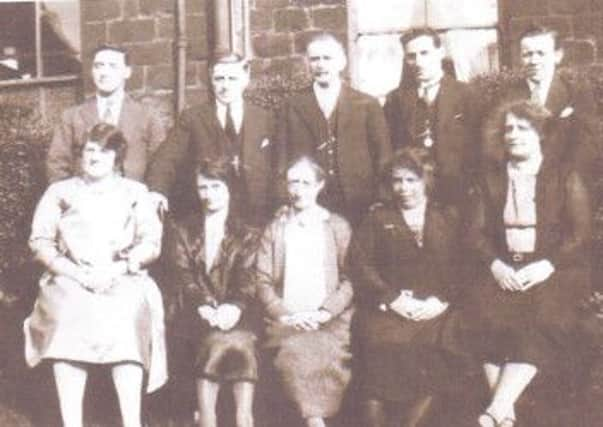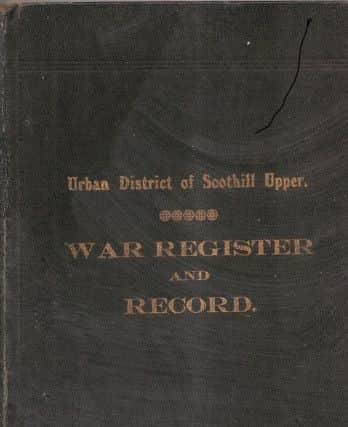Nostalgia with Margaret Watson: A truly priceless book


It is a war register showing details of men from the village of Hanging Heaton and surrounding areas, who went to fight in the First World War.
It gives details, not only of those who died, but those who served, those who were in prison camps and those who were wounded.
Advertisement
Hide AdAdvertisement
Hide AdThe book started life on the day the war began, and it is thanks to the then vicar of St Paul’s Church, the Rev W E Cleworth, that the register was completed and eventually made into book form.


The names of those who gave their lives are listed at the front of the book. They are also inscribed on the war memorial in the village churchyard as well as on the one in Crow Nest Park.
But what makes this book different to other war memorials is the fact that it also lists the names of those who came home.
The book belongs to Mr David Coates, who has lovingly taken care of it since the death of its owner – his grandfather, Leonard Norton, who lived in Bromley Street, Hanging Heaton, and who served in the war.
Advertisement
Hide AdAdvertisement
Hide AdAlthough Leonard had been injured and suffered serious wounds, he was one of the lucky ones who came home, married and had children and grandchildren.
How proud he must have been to discover on arriving home that the village people of his youth had not forgotten him but had been keeping a record of everything that had happened to him.
Only a few copies of this book I am sure will have survived, and this is why I feel it should be republished so that the descendants of those named in it, will be given a chance to own one.
With this in mind, I have arranged, with the agreement and support of Mr Coates, to get a second edition published as soon as possible.
Advertisement
Hide AdAdvertisement
Hide AdAt the moment we are planning to publish only 50, and many of these are already spoken for, but we want to give other people a chance to buy one now.
Before going ahead with publication, we need to know how many of our readers would like to order one, or to subscribe to the cost of publishing.
Both David and I are determined that the book should be of the same high quality as the original one, an exact replica in every detail, hard-backed, linen lined, and gold lettering on the cover.
It does not come cheap and so the cost will be £20, with any profits going to local charities. If you don’t want to be disappointed, please let me know as soon as possible, if you wish to order one. Details of ordering are at the bottom of the page.
Advertisement
Hide AdAdvertisement
Hide AdI would like to point out that two military historians I have spoken to have said that if this book was marketed correctly, it could be a best-seller and raise thousands of pounds for charity.
Unfortunately, I don’t have the time or expertise to do this, and so at the moment our plans are to publish a limited amount and sell them through this article and word of mouth.
My aim all along has been to get enough copies published to ensure that this book is available in local libraries and schools for future generations to read.
At the time this book was being compiled, Hanging Heaton was part of the old urban district of Soothill Upper, with boundaries extending into parts of Shaw Cross, Earlsheaton and Crackenedge.
Advertisement
Hide AdAdvertisement
Hide AdThe book is a record of the war service of the men living in that district during the momentous period August 4, 1914, to the Armistice November 11, 1918, and the signing of the Peace Treaty, January 10, 1920.
At the declaration of war, the Rev Cleworth, vicar of St Paul’s Church, began the register, and as the war proceeded, gathered information from every available source to ensure accuracy of detail.
What is most touching about the development of this book is the way parishioners formed themselves into a committee and then went round the district knocking on doors to find out who was fighting in the war.
More than 1,000 record forms were printed and distributed and more than 900 were returned. I don’t know if all the men who fought were recorded because some forms were not returned, but the vast majority certainly were.
Advertisement
Hide AdAdvertisement
Hide AdThe book makes fascinating reading and many people will find in it the names of long-lost relatives they knew nothing about.
Two of the men mentioned were uncles of my husband, and we discovered that one of them, Uncle Victor, had been in a prison camp. We knew he had fought in the war with his brother Bernard, and that he had been wounded – but he never once spoke to us about his two years in a prison camp.
Exact care was taken to secure accuracy of detail in order that the book might be a lasting and correct record worthy of preservation.
The foreword to the book states: “The ultimate result is that the book now commended to the reader is a trustworthy record of those connected with Soothill Upper who served in His Majesty’s Forces during the great European War.”
Advertisement
Hide AdAdvertisement
Hide AdThe foreword, written by four members of the committee, including the vicar, continued: “The granite Memorial Cross erected by public subscription in the parish churchyard, bears the honoured names of those who gave their lives for their country, and this book provides, a permanent record of those who survive, as well as those who have crossed the bar.”
A number of those recorded in the book were volunteers, many just in their teens. Some joined up within days of war being announced.
The following is a short list of some of those mentioned in the book, who were killed:
• Joseph Bailey, of 12 Owl Lane, Shaw Cross, Private 3628,1/5, of Well WR Regiment. Aged 17 years. Began December 26th, 1914. To France where he was killed by rifle shot between the trenches, on November 11th, 1915.
Advertisement
Hide AdAdvertisement
Hide Ad• Ernest Broadhead, Victoria Crescent, 377 Leeds Road, Hanging Heaton, L/C 7th Suffolk Regiment from 20th Hussars. Aged 18 years. Began September 17, 1914. To France June 1915. Egypt, October 1915. France again, September 1916 where he was killed in action, April 28, 1917, near Arras.
• Walter Hatfield, 41 Caulms Wood Road, Crackenedge. Private, 26144, Kings Own Yorkshire Light Infantry. Aged 19 years. Began January 20, 1916. Served in France. Killed in action at Bethune, September 14, 1916.
The following are just three of those in the book who came home – Leonard Norton, to whom the book belonged; his brother, Irvin Norton, and his brother-in-law Charlie Boothroyd, who was also an uncle of Baroness Betty Boothroyd:
• Leonard Norton, 41 Bromley Street, Hanging Heaton. Private 242168, 2/5. KOYLII. Aged 20 years. Began March 23, 1916. Discharged from hospital, January 29, 1919. “Physically unfit for Military Service.” Wounded on three occasions. January, 1917 at Bullecourt. May 3, 1917, at Passchendacle. And severely wounded at Bouquoy on May 25, 1918. Invalided to hospital till discharged.
Advertisement
Hide AdAdvertisement
Hide Ad• Irvin Norton, 59 Hollinroyd Road. Private 40007. 7th KOYLI, aged 22 years. Began October 1916. Discharged January 1919. “physically unfit for military service.” To France and Belguim, January 8, 1917. Wounded severely on two occasions. November 1, 1917. Invalided to hospital in France and England. Under medical treatment in England from June to December, 1918.
• Charles William Boothroyd, 41 Bromley Street. Private 20716, RAMC, to West Yorkshire, to 2/7 Leeds Rifles, aged 23 years. Began October 2, 1916, ended January 26 1919. To France, November 6, 1917. Gassed at Bucquoy, near Arras, June 18, 1918. Wounded at Cambrai, September 28, 1918. Under medical treatment till January 26, 1919.
Anyone wishing to order a book should email [email protected] or phone 07528 452761, when details of delivery and payment can be discussed.
Next week I hope to write further on this and include details of the war memorial at St Paul’s and how the money to erect it was raised by public subscription.